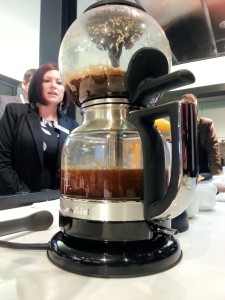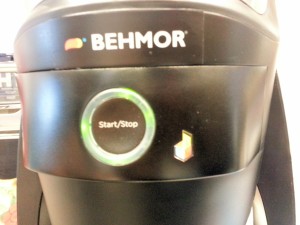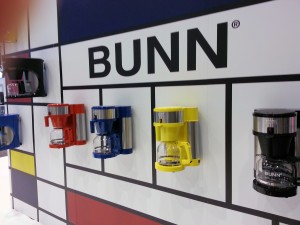

The Coffee Maker Emerges: SCAA Seattle Event 2015
 I keep saying we’re living in a golden age of coffee brewing. This year’s Seattle SCAA Event brought more brewers. There are even a few coffee discoveries to report. Here are some highlights:
I keep saying we’re living in a golden age of coffee brewing. This year’s Seattle SCAA Event brought more brewers. There are even a few coffee discoveries to report. Here are some highlights:
Nick Kohout of Arcaia showed me some scales that, frankly, did not impress me at first. I mean, they supposedly have some higher-end parts than comparable Bonavita scales, but does that excite anyone? I’ve had no problems with any Bonavita scales, not that I’m a barista, but I’m just being honest. Then he showed me how its timer keeps track of the contact time in manual brewing. Apparently, it detects when the water has gone through the grounds, and pauses the clock. Now I am excited! Their goal of connecting folks via the web so they can meaningfully compare their brews is also a step in the right direction.
Lots of new coffeemakers, some Kickstarter projects and others already developed and seeking coffee stores to recommend and sell them to customers. Gregory Bombeck’s Phoenix coffeemaker was one. Another was the Kinto coffeemaker from Japan. Saint Anthony Industries has one of the most beautiful cold brew makers I’ve yet seen, although the whole cold brew thing leaves me… oh, I won’t say it.
My own personal favorite was from 21 year-old Cameron Hughes of Invergo Coffee, of Garden City, New York. His brewer’s patented swiveling spray head may have cracked a problem that’s plagued automatic drip makers since George Bunn introduced the first Bunn-O-Matic in the 1950s, and that is how to effectively mimic the way you and I pour water so beautifully by hand. He also claims you can set the brewing temperature, not revolutionary, but makes me want to test his machine in my kitchen. My at-show tasting was compelling however. Remember, Orson Welles was twenty one when he became famous in radio. Post-moderns may prefer a Beatles analogy.
At the Remarkable Indonesia pavilion, they were tasting some interesting coffees. It’s no secret that I’m a fan of this country’s coffees. The flavor diversity is astounding, and I can only assume that it’s distance and the fact the only a select few green buyers (think Geoff Watts) ever makes the trek (20 hours-plus) to actually visit. My personal taste favorite was Bali coffee. I admit I have a guilty pleasure for some of their robusta varieties as well. But the news this year was their showing clips of a new film, Aroma of Heaven, created, written and lensed by cinematographer Budi Kurniawan. Budi K, as he introduced himself, is almost as interesting as his film. A compulsive shooter, he had a camera in his hand both times I’ve seen him. I predict this film will be a big hit among coffee enthusiasts. It deserves special mention for being the first film to not seem like a colonialist perspective, but rather an honest, if not bitter, but also not candy glossed look at coffee. Indonesia goes pretty far back in coffee history, by the way. Budi says a download is going to be available, but I’m pitching for some neighborhood showings (I know someone at CoffeeCon hehe). It’s a remarkable film, and thanks to a screening of it in entirety) I speak with confidence.
I’ve been trying to track down Breville products for reviews for years. Fortunately, a changing of the guard has opened transparency and Category Manager Alejandra Lin has pledged to get us some of their products that are promising. I’ve heard good things about their grinders, but talk (especially about grinders) is cheap. Let’s get one and do some measurements, which is what matters. Breville really had something that caught my attention. Alejandra told me their automatic drip maker has the ability to modify its contact time according to volume. As you may know, most automatic drip makers’ contact time between the grounds and hot water is optimized for one specific cup size, usually, but not always, the maximum. Make more coffee, it’s too strong/bitter. Make less, it’s weak/undeveloped. If the new Breville machine delivers, it will be front page news (here anyway!).
The show surprise was this new stovetop coffee roaster. Jung Park of Dr Mahn Coffee brought his new design from Korea, which seems to be experiencing a coffee renaissance of new innovations. Can’t wait to try it, remembering both the 1990s Palani Pan roaster and the importance of a kitchen fan when roasting over fire. What this country needs is a simple professional quality sample roaster on par with the classic Siemans Sirocco coffee roaster long out of production (spotted one last week on eBay, which was snapped up before I could say “Buy it Now”. I think I may have found it. Luke Kawa of Kawa Coffee had one, which is also extremely attractive, but how it roasts will be what interests me most, of course.
Remember a Netherlands company named Bravilor? They used to be distributed by Boyds. I always thought of them as a commercial version of Technivorm. They are about to introduce a consumer automatic drip coffeemaker. Seemed very robust, but not coffee samples at SCAA. Might be ready by CoffeeCon Chicago in July, according to Eric Covelli, Bravilor Marketing
VP. Had a delightful dinner with Kenneth Davids, famous author of many books on our favorite subject. One of our topics was the current Geisha coffee craze. According to Professor Davids, there are genuine attributes to the Geisha cultivar. One such sample (roasted here in Chicago by Big Shoulders) earned a whopping 96 rating in a recent CoffeeReview.com tasting.
Bonavita had their latest 5-cup maker and many other products on display. They’re an amazing coffee maker success story. I’m particularly interested in this size category because as more people buy specialty (read: expensive) beans, they’re going to take a closer look at over-brewing those twelve cups, when they each have a couple (read: 4). Marcus Boni assured me a sample will be sent and, of course, a review will result.
Jim Shanley is a farmer with a unique geographic location. He’s in California and his farm is aptly titled, California Coffee Farms, the first I know of in the continental 48 states. Hopefully I will try some soon.
Robin Thorum spoke to one of my favorite subjects, testing grinders. Mr Thorum’s company has done a lot of research on measuring irregular objects such as coffee grounds. According to him, laser measuring tools presume all ground particles to be spherical, which would be nice, but anyone can see this is not so. Ditto traditional sieve tests, where oblong grind particles outsmart screens and slither through, which gives inaccurate comparisons. What we want to measure of course is surface area. He claims his company, Coffee Laboratory, has developed a better, more accurate way to measure this surface area.
At the expense of getting a little sniffly, there were several awards given to longstanding coffee industry members that deserve mention here. First, Carlo Di Riocco, whose Mr Espresso is the curator of what many of us consider the true Italian espresso. Di Riocco started as an engineer, but combined his insistence on consistency with art. I compel anyone to find a finer drink. He’s also kept doing the right thing against various fads in espresso roast, preparation and serving, a combination that’s kept his product unique.
Oliver Strand was able to do what no other comparable media personality has, and that’s bring coffee to the pages of a big city newspaper, in this case the New York Times. The coffee people I know don’t always agree with him, but that fact is they read everything he writes. So do mainstream readers and that’s what’s most important. If coffee is really the next wine it needs to enter culinary arts columns nationwide. The best part to me is he is real. He really is a coffee enthusiast, not a poseur. I still cringe when I view how coffee has been presented on the Food Network.
Finally, La Minita’s Bill McAlpin was the first person I called after I read a Corby Kummer Atlantic article about coffee. After hearing my own enthusiasm for coffee and wanting to learn and write about it, spent an hour or more discussing it with me, and even introduced me to Ken Stevenson and others so I could get a proper education. I’ve met no more generous person than him in the years I’ve been a coffee scribe. The fact that La Minita defined what is now called a specialty coffee farm is possibly of equal importance. Oh yes, and the coffee is always great! Bill McAlpin was finally properly honored this year. I was surprised to see the outwardly cooler McAlpin get glossy-eyed while receiving his award. Mr Espresso seemed to foster a trend, making these normally staid awards a three-hanky one. Even I wasn’t immune from tearing up a bit seeing these greats get their just acknowledgement.
Finally, we surprised to see OXO, seemingly moments after the Chicago International Housewares Show. Claire Ashley and her team brought their new coffeemakers and accompanying grinder, which features a built-in scale. Lots of folks whispering about it, as I think it shocks them to think a large housewares company (admittedly mostly unpowered) might enter the coffeemaker sweepstakes. I keep telling folks, brewers are the power behind the glory in every great cup of coffee. Great job, SCAA. Another fun and productive trade event.
International Housewares Show Coffee Report: 2015
 I keep saying that if you don’t get into coffeemakers, your coffee at home will never be great. The best trade show for the gear isn’t a coffee show at all – it’s the International Housewares Show.
I keep saying that if you don’t get into coffeemakers, your coffee at home will never be great. The best trade show for the gear isn’t a coffee show at all – it’s the International Housewares Show.
It’s where I discovered the Chemex, the Aeropress, KitchenAid’s legendary 4-cup, Bonavita, Technivorm and of course my first Bunn, the A10. Not bad for one event! They don’t really want consumers here. I get to go because I keep writing this blog and various articles. Even I used to get ignored because the sellers are always on the lookout for Macy’s buyers. Can’t blame them. I ask a hundred questions and might buy one, where department store buyers are going to buy a case for each store. It keeps me humble.
This year’s event had several new, innovative products. Let me give you a quick (by my standards) rundown. None are reviews. I sometimes look back at first-tastes and see them for the infatuations they are. I believe in long courtships regarding coffeemaker testing. 30 days is the minimum, and it reduces/eliminates new car smell, packaging, and gives me time to do old fashioned things like read the instruction book and tweak products a bit before shooting off my pen, figuratively speaking of course.
 Behmor won the Innovation Award, Kitchen Electrics, International Housewares show award for Joe Behm’s Brazen Connected 8 Cup Brew System. I was perhaps the first to review the Behmor Brazen, so you already know its leading edge position among brewers for its variable temperature setting, variable pre-infusion times (you can actually brew same-day roasted coffee without foaming overflows!) and altitude settings, which likely mean nothing to New Yorkers or Chicagoans, but are the only way to achieve SCAA-recommended brewing temperatures in Denver. Joe won his award (which kept him from showing up at CoffeeCon NYC) for the brand-new “connected” version of his brewer.
Behmor won the Innovation Award, Kitchen Electrics, International Housewares show award for Joe Behm’s Brazen Connected 8 Cup Brew System. I was perhaps the first to review the Behmor Brazen, so you already know its leading edge position among brewers for its variable temperature setting, variable pre-infusion times (you can actually brew same-day roasted coffee without foaming overflows!) and altitude settings, which likely mean nothing to New Yorkers or Chicagoans, but are the only way to achieve SCAA-recommended brewing temperatures in Denver. Joe won his award (which kept him from showing up at CoffeeCon NYC) for the brand-new “connected” version of his brewer.
With the Behmor Connected you will be able to go online and download Counter Culture’s (or other roaster’s) recommended settings for his brewer. This means even more. I can envision barista champs blogging their favorite recipes and settings for coffees ala celebrity chefs (that they really are of course) and finally being able to achieve at home exactly what they are doing in the cafes. Meanwhile, it should double Behmor’s market because more casual consumers who just care about taste, not geeky tweaking, and give them easy downloads to load.
An interesting new startup is Brewista, the brainchild of Bonavita co-owner and inventor, Brian Gross. Brian is one of the great minds of coffee brewing. He talks faster than anyone I’ve ever known, and it’s all content. He’s establishing a coffee product innovation think tank, and future manufacturing site in Cheyenne, Wyoming! He’s releasing a line of simplified Bonavita products that will feature fewer features, and lower costs to bring things like their kettles to a wider audience. Brian is working on online interconnectivity with coffeemakers, which means more sophisticated brewing and simplified operation for sleeping early-morning operators. The thing that he was most excited about was his onsite coffee shop almond milk extractors for cafes. Of course, a home version cannot be far behind. Keep an eye on Brewista. Brian has a great track record with Bonavita, and among coffee’s best overactive imaginations.
 Bunn had a wall of colorful brewers. At first I thought they’d kidnapped an Italian designer and brought them to Springfield, but it turns out they were only for display. They did have their home Trifecta on hand. I can’t help continuing to believe they should sell those in a Bose-style direct program (the pricing/profit margins are too low for mainstream retailers, even so-called high end ones like Sur La Table or Williams-Sonoma). A Connected Trifecta has to be in the works, but if it is, they’re keeping mum about it. Hope they walked the show.
Bunn had a wall of colorful brewers. At first I thought they’d kidnapped an Italian designer and brought them to Springfield, but it turns out they were only for display. They did have their home Trifecta on hand. I can’t help continuing to believe they should sell those in a Bose-style direct program (the pricing/profit margins are too low for mainstream retailers, even so-called high end ones like Sur La Table or Williams-Sonoma). A Connected Trifecta has to be in the works, but if it is, they’re keeping mum about it. Hope they walked the show.
Bunn still makes the best tasting K-cup machine I’ve yet tried. It hits the 196°F mark easily, and, used in tea (pulse) mode, does a very nice cup. iCoffee is my single nod to K-cups. I lost interest in Keurig after they released the 2.0. It has the faults of the first generation, and some new bad habits like the locking mechanism that forces you to use mediocre coffees. Too bad too, because there are some good local roasters churning out fresher, higher quality K-cups. The Keurig 2.0 is not a bad machine, in fact it is amazing for what it does, but it was designed to expand its use for many beverages, soups etcetera. It makes good (not great) coffee.
iCoffee, brainchild of Bruce Burrows, who purchased the old Remington name (they used to be a high quality coffeemaker brand). The iCoffee does extract more thoroughly than Keurig’s or most other K-cup machines. And it uses any K-cup, just as Bunn’s does, so there’s no problem filling it with the really good ones coming out. Who’s got good K-Cups? La Minita’s own brand of K-Cups, made with proprietary filters made from surgical fabric and recyclable after peeling foil, are the best I’ve yet tried. I know K-Cups are under ecological and sensory fire, but they are market reality and, as Mc Alpin and Boyd’s have proven, can be made recyclable.
KitchenAid hosted a little reviewer party one morning at their nearby (it’s not that near) showroom. I was just wowed when KA Product Development Manager Meighan McLaughlin started brewing for me with their new Siphon (vacuum) coffee maker. It has automatic cycle, a permanent filter, and has a glass top, yet features steel reinforcement at the traditionally weak points. KitchenAid also has a new grinder, with claimed burr refinement. There’s even a new KitchenAid French press which operates on AA batteries.
 I’ve saved Oxo for last. Oxo makes a lot of rubber-sided kitchen hand tools. I have their can opener, and nothing else, but it works well. So what are they doing in the coffeemaker business? Apparently, according to their charming French Senior Product Manger, Claire Ashley, they decided to enter the coffeemaking market after analyzing the current one and realizing how mediocre most coffeemakers are. Obviously, CoffeeCompanion fans know this, and also know I simply ignore most of the ones that can’t extract properly, but having searched last year for my Consumer’s Digest report, I can say that likely 80% of the ones in mainstream department stores are genetic failures in the kitchen.
I’ve saved Oxo for last. Oxo makes a lot of rubber-sided kitchen hand tools. I have their can opener, and nothing else, but it works well. So what are they doing in the coffeemaker business? Apparently, according to their charming French Senior Product Manger, Claire Ashley, they decided to enter the coffeemaking market after analyzing the current one and realizing how mediocre most coffeemakers are. Obviously, CoffeeCompanion fans know this, and also know I simply ignore most of the ones that can’t extract properly, but having searched last year for my Consumer’s Digest report, I can say that likely 80% of the ones in mainstream department stores are genetic failures in the kitchen.
Oxo first showed me their grinder; that they showed me the grinder first is a good sign. It has a built-in scale and automatic shutoff by weight. The upper beans bin is removable and sealable. If it grinds properly, (only testing can determine this) they might really have a powerful entry. They are introducing two coffeemakers. First, the 1 liter one has a glass tube so water at its hottest never touches plastic (although the grounds holder is BPA-free plastic). They have also developed algorithmic internal software that allows you to do various batch sizes and still deliver the same grounds/water contact time. This results in consistent tasting brew, whether you make two cups or eight. If it works as promised, it’s a great feature.
The second model offers a larger 12 – 4.5 oz cup batch size. According to Ms Ashley, Oxo designers recognized the heating limitations creating enough pumped hot water to do this, which she says is impossible with current technology. So, they are heating all the water at once, and then release it at approved brewing temperature. Both brewers feature tubes to release brew at carafe bottom in order to mix coffee before pouring. An unusual innovation is a transformer feature where you can remove the boiler and use it as a water kettle. Exciting!
As Sherlock Holmes, and later Carly Simon, say: These are the good old days!
No Results Found
The page you requested could not be found. Try refining your search, or use the navigation above to locate the post.

